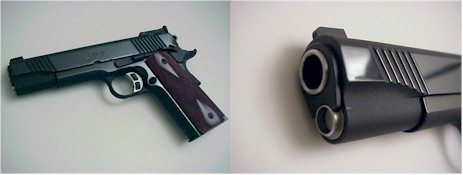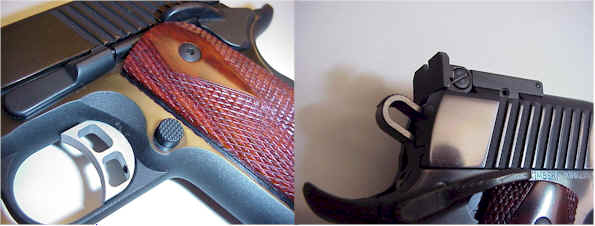|
||||||||||||||||||||||||||||||||||||||||||||||||||||||||||||||||||||||||||||||||
A Kimber in .45 Super1 for under $8 ? - Part I Introduction I have a .45 Long Colt Ruger Bisley that sees a great deal of use. Dependant upon the handloads I select, I can pack up the Ruger and spend a day at the range, introducing people to shooting sports, without the negative aspects of significant recoil and a lot of muzzle blast. I could just as easily pack heavier loads, and effectively use the same gun for deer and boar hunting. If I went for a thick wall, 5 shot cylinder, Linebaugh type conversion I could extend the already broad useful range of the cartridge another several hundred feet per second. The Ruger can perform to almost twice the cartridge's original black powder ballistics, but many changes have been made to the cartridge case, bullets and gun design to make this possible. Unless you're shooting antique ammo out of an antique firearm, the .45 Long Colt ammo and gun you're shooting is probably as new as that .300 Ultra Mag still sitting on your gun dealer's shelf. It's literally been decades since weak balloon head brass has been produced, and there are few modern versions of the single action revolver designed to handle only low pressure loads - like Colt Manufacturing, with a habit of producing low quality/over priced collector pieces, and insistence on supporting anti-gun government policy and candidates. But that's another story... With generational firearm and cartridge modernization come economic benefits to the shooter. You get to use a favored gun under more circumstances, and you won't incur the cost of: another gun, loading dies, shell holders, bullets, powder, brass, sights for the new gun, sling, case, and so on, and so on.... Guns are, in fact, the Devil's spawn, not because of their intent or purpose, but because of the $10,000 that can be spent on accessories and peripheral products in support of a $300 gun. Consequently, if you have one gun, one full time job will support your habit. Two guns ? Two jobs. Three... I believe the .45 SuperŪ, for many .45 ACP owners, offers the same magnitude of improvement as the .45 Long Colt and, potentially, with a very small investment. Before we begin Disclaimer - To the best of my knowledge Ace Custom .45's Inc. holds the Trade Mark for the .45 SuperŪ name and is the only organization that can authorize or license the display of the .45 SuperŪ logo on products. The end product of this project will not be labeled .45 SuperŪ. .45 SuperŪ brass and ammo are widely available, and there is no law prohibiting the use of this cartridge or the independent chambering or conversion of an existing gun as long as the .45 SuperŪ is not displayed without authorization. This project was conducted completely independent of Ace Custom .45's and, for those of you familiar with my work, there is no chance of it having commercial value. Regarding component parts used in this project - No manufacturer represented their products as applicable to a .45 SuperŪ conversion or adaptation. Virtually all have taken great pains to define the correct use of their products. This project represents an experiment undertaken at my own risk. I will present my findings and conclusions, as well as the underlying logic, however this does not necessarily make my assumptions valid. Clearly this series of articles is not to be construed as direction for others to follow. What does all of this mean ? At a time when Sears puts a warning tag on it's table saws, "Don't stick your face into the rotating blade", I want to make sure that conscientious independent parties are not held liable for my actions, and people don't take information stemming from my personal pursuit of a hobby as gospel. A preliminary look I happen to like the .45 ACP cartridge. I also very much like the heft, feel and operation of the 1911 design auto. The combination can be exceptionally accurate, the guns fit my hand well, and the .45 ACP and +P pack a pretty good wallop. However, in recent years, I've moved away from the .45 to some of the speedier smaller bore guns, which seemed to offer a little more punch and a little more reach; notably the .357 SIG and the .40 S&W. But as I began to dig up more pieces of information on the .45 SuperŪ, there seemed to be an opportunity to revive my interest in some favorite handguns. It would be difficult to overlook the potential for a substantial increase in performance over the standard .45 ACP and .45 ACP +P, as well as the increased flexibility of having the choice of shooting any of the three rounds from a firearm modified to safely use the Super cartridge. In summery -
A good reason for selecting larger bore firearms; heavy bullet weights lead to substantial increases in kinetic energy, with only relatively moderate increases in velocity, while still maintaining relatively low chamber pressure. Quality 1911 design pistols are routinely chambered for cartridges with operating pressures in the 32,000 - 38,000 psi range, so the increased pressure of the.45 SuperŪ seems not to be of consequence. Another characteristic of the .45 ACP and related or similar rounds, that makes them desirable for broad application; charges from low end to high velocity with popular powder selections, yield increments of approximately 50 fps for every .3 grain change in powder loads. Some cartridges spike up or down in velocity as they move away from mid range load. The .45 ACP, +P and .45 SuperŪ appear to remain very stable across the entire spectrum of loads. What is a .45 SuperŪ conversion ? I won't go into the history of the .45 SuperŪ. The cartridge has been around in one form or another since 1988, and in factory loaded form for about the past 5 years. The Ace Custom web site covers the history in detail. The .45 SuperŪ is available in custom gun form, as a conversion to a customer's gun or from Ace Custom .45's as a kit for gunsmiths to apply to their customer's guns. Whole gun and converted customer guns in .45 SuperŪ are also available through Robar, and new .45 SuperŪ guns are being made by Springfield Armory within their ported barrel V series. I will say that it's a little difficult to define exactly where a .45 SuperŪ differs from a standard .45 auto. Suppliers seem to wrap up the core of the .45 SuperŪ modifications with various unrelated modifications and extraneous components, presumably to make a relatively stiff price for a very small modification a little more palatable; $350 for the conversion and $192.50 for a gunsmith parts conversion kit. As an example, the Ace Custom shop conversion is listed as -
.45 SuperŪ brass is externally identical to standard .45 auto brass - making 1, 2, 5, and 7 seem irrelevant, 6 is worth a little more investigation, which leaves essentially a one piece guide rod and dual spring set installation as the functional part of a $350 conversion package. The gunsmith installed kit appears to be the same, less the ejection port and jeweled surfaces work, but inclusive of other unrelated material. I think the cost of converting the right gun to shoot .45 SuperŪ would be about $7 - $8, and that's what this project is all about. The critical areas of a conversion appear to be - .45 ACP and .45 ACP +P brass cannot be loaded to .45 SuperŪ levels. The .45 SuperŪ case is of special design and thickness, made to withstand the additional pressure in a standard .45 ACP chamber. Always check for the .45 SuperŪ head stamp on a case before handloading to Super specs. Loading standard or +P .45 brass to .45 SuperŪ levels most likely will result in total cartridge case and firearm failure, with the potential for grave personal injury. The correct brass is available from Starline Brass. Loaded ammo is available from Triton and distributors. Loaded ammo is around $25 for a box of 50 rounds. Brass runs about $65 per 500 rounds. The .45 SuperŪ uses standard .45 ACP dies and shell holders, and utilizes traditional powders and large pistol primers. If you get even 10 loads out of a case, you can handload a quality box of 50 for $10 - $12. .45 SuperŪ cartridges should never be fired from guns not been modified for this purpose. Slide hammering, caused by firing this cartridge in a firearm not modified for this specific purpose, could potentially result in the failure of the firearm's frame and slide, as well as serious injury to the shooter. All guns chambered for the .45 ACP cannot be converted to .45 SuperŪ. Some limiting factors are: guns with alloy frames, guns with barrels offering less than minimal case support, an inability for a gun to withstand elevated chamber pressure, guns with low slide mass such as short slide Officer's models or stamped slide Glocks, guns that lack availability of heavy recoil and firing pin springs. Shops authorized to perform .45 SuperŪ conversions on customer guns maintain individual lists of the guns they will work on. As an example, Ace Custom .45's will not modify Commander size guns for full power .45 SuperŪ use, but they do seem to convert guns from a broader array of manufacturers than other authorized conversion companies. Heavy recoil springs require heavy firing pin springs. Using a heavy recoil spring, and a light or standard firing pin spring, could permit the firing pin inertia to overcome the resistance of the firing pin return spring, when the slide's forward motion comes to an abrupt stop, causing the firing pin to strike the primer of a newly chambered round. Never install a heavy recoil spring without installing a corresponding heavy firing pin spring. The rule of thumb for .45 SuperŪ gun preventative maintenance seems to be spring changes every 2,500 to 3,000 rounds to prevent spring fatigue and subsequent frame battering. Verifying information Brass: I examined samples of some brass for the .45 ACP (Winchester), the .45 ACP +P (Starline) and the .45 SuperŪ (Starline). I anticipated the difference amongst these cases would be obvious, but this wasn't the case, so I went on to weigh and measure each of them.
The Winchester brass was shorter, .002" thinner, but 5% heavier than the heavy duty brass from Starline. I though the Winchester brass was possibly made from a more dense brass alloy, but I decided I needed to section a sample of each to verify the published statement, "the .45 SuperŪ brass is significantly reinforced, a critical feature". I was also starting to think the .45 SuperŪ was only an overloaded .45 ACP with a heavy recoil spring.
From left to right - .45 ACP, .45 ACP +P, .45 SuperŪ. The difference is actually quite significant in the web area, as marked by the yellow vertical line. The Winchester measured .175", the Starline +P .182" and the Super .198". .023" over standard is a lot of brass and makes it easy to see what the Super brass is critical to proper function and safety. This extended area means the part of the Super case that hangs unsupported over the barrel's feed ramp is solid brass, where the standard case would have a portion of the cartridges powder cavity protruding into an unsupported barrel area. Starline shipped .45 SuperŪ the day after I placed my order. Springs and Slide Weight: A Colt 1911Government pistol chambered for the .45 ACP has a 16 lb recoil spring. Within a selection of conventional and variable springs, there are rates available from 5 through 28 lbs in 1 to 2 lb increments. Light target and practice loads can utilize considerably lighter spring rates, heavy loads as in +P require higher than standard spring rates. So one of the factors in determining alternative spring rates is how heavy or light of a load will be used in the gun. A second factor in determining spring rates is slide mass. The larger and heavier of a slide on an autoloader, the lighter the spring rate requirement. As an example, a Colt Commander uses 18 lbs as a standard spring rate, the Officers Model with the shortest and lightest slide utilizes a 22 lb spring. When setting up for the .45 SuperŪ both aspects of spring selection need to be taken into consideration a) The higher velocity of the round and subsequent increased force working against the slide as the gun cycles b) The slide mass and a determination if a spring of the correct rate could reasonably be applied to the conversion. As an example, a Colt government model or equivalent uses a 16 lbs spring for standard applications. The .45 SuperŪ utilizes a 30 lb spring in the same type gun for full performance loads, tactical loads may have a lesser requirement. But an Officer's Model begins life with a 22 lb spring, and there would be few places to locate a 44 lbs spring. I decided I would go with a standard length gun to avoid complications in this area. If you're looking for spring related info and springs, stop by the Wolff site. There is a tremendous amount of information covering spring types, selection and application, plus they actually are very prompt and helpful in responding to e-mail questions. No, this is not a paid commercial, I just believe that good firearms related companies need to be supported and recognized by enthusiasts. Light slides and alloy frames: Generally speaking, full size, steel auto's from most manufacturers can be setup for the .45 SuperŪ. Ace Custom maintains a partial list. Beyond slide length, very low mass auto's like the Glock can't be converted, as well as guns with light alloy frames. The concern is that the slide will hammer the frame until it cracks. There are some exceptions of course. Some models of Glocks can be modified with a heavy bull barrel to make them functional with tactical level loads. I elected to go with an all steel gun that adheres closely to the 1911 design. Matching recoil and firing pin spring sets: Quality suppliers like Wolff springs, pack matched sets of springs; the firing pin spring that is packed with a new recoil spring is selected to withstand the firing pin's increased inertial force, as generated by the increased rate of the recoil spring.
The Project Gun With these thoughts in mind, I went looking for a gun to use as the subject of this project. I actually intended to select a Springfield Armory V long slide in .45 Super that I could disassemble and use to collect data. Unfortunately, or maybe fortunately, trying to locate one was a pain in the butt. About a week passed and I was standing in a gun store with my wife, grumbling about the empty rifle racks and missing big bore guns, when the sales guy put a Kimber Gold Match in my hands. Nice gun, very nice gun. In fact, it was the first 1911 type that felt right since I bought a 70 Series Gold Cup about 100 years ago. The gun was blued steel, my favorite, and it came with most of the features I usually end up installing after I purchase a gun. Yet no yipes stripes, Star Trek looking accessories, and apparently no one tried to "melt" the gun lines to prevent it from hanging up on my underwear when I try to fast draw in public to win over the anti-gun faction. What stood out was the muzzle heft and the very smooth slide action. No grittiness in the slide and uniform pressure from one end of travel to the other. I even liked the front slide serrations. Great trigger. I got the oh so special , "I'm a gun dealer, so I want you to believe I sympathize with you, but since Kimber took the retail prices off the web site, I'm really going to hose you" price. Then I disappeared for 10 days while refugees from CA DMV checked my worthiness to own a gun. Actually I've never personally had a bad experience at the DMV, or the post office for that matter, so I used DMV based on it popular reputation. Of course, guys like me are probably the reason...
So without disturbing the lock, I popped open the case as it appears in this picture, and stowed my receipt and case keys inside of the case. Then, again without opening the lock, I removed the gun and popped out the clip so it wouldn't be in the gun while it was being transported. Who was the lock for ? There is no hole in the case or gun that this local government mandated lock could pass though or secure, but I was forced to pay for this over priced lock (Hillary Lock Company, I believe) which prevented nothing. Thanks for letting me relive that moment. The gun has several features that will help as I try this conversion. It comes standard with a single piece guide rod and reversed bushing. It has a heavy full length slide and uses standard government length springs - high slide mass and wide choice of parts to experiment. The gun is optionally chambered for the high pressure .40 S&W and .38 Super, both which operate at pressures higher than generated by the .45 SuperŪ, and this is a heavy, full size, non-alloy 1911 type pistol.
The Kimber is a nicely finished piece. Good polish, even bluing, and good fit of all parts. The Gold Match blue steel is shipped with stainless barrel, spherical bushing and guide rod assembly. All which look correct on the gun. Shaking the slide on this gun, then shaking the side on several of my other Colt 1911, makes me wonder how Kimber kept such a tight fit, while retaining easy operation of the slide. The front sight is fitted into a dovetail for drift adjustment. I guess I'll have to live with the disappointment of drilling out and re-staking front sights.
Not a piece of plastic on this gun, zip. Aluminum trigger, steel mainspring housing. The wood actually fits closely to the metal parts, checkering is clean, and all the controls are within easy reach and crisp in operation. The rear site is tucked into a dovetail. I'd grown use to drifting the roll pin into the rear sight of my Gold Cup every 500 rounds, or replacing the rear sites on my Officers and Commander models as they fall off at the range. Other than concentrating on the .45 SuperŪ conversion, there is little else for me to do to the gun. Maybe clean it...I think it was packed in tar, or.. This coming week I'll pull some ammo together, .45 ACP, .45 ACP +P and .45 SuperŪ and see if I can qualify some of the spring sets and work out the issue of firing pin change necessity. Be back with more. Thanks 1. ".45 SuperŪ" is a Trade Mark of Ace Custom 45's Inc. |

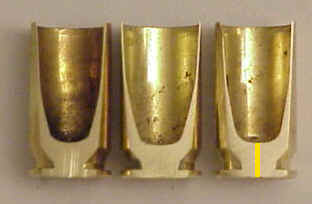
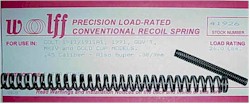 Springs
are cheap insurance and a little juggling can really enhance the
performance, reliability and durability of a firearm. Wolff sells
tuning sets, spring rates incremented up and down the rate scale.
This type of pack allows the shooter to change up to match the
types of ammo being used. In a future installment I'll review how
springs rates are selected and verified as appropriate.
Springs
are cheap insurance and a little juggling can really enhance the
performance, reliability and durability of a firearm. Wolff sells
tuning sets, spring rates incremented up and down the rate scale.
This type of pack allows the shooter to change up to match the
types of ammo being used. In a future installment I'll review how
springs rates are selected and verified as appropriate.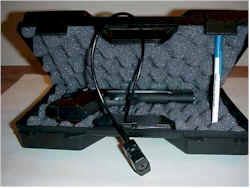 I
get a little crazy over gun legislation, not so much for its
prohibitions, but rather its stupidity. This is a politician's
solution to violent crimes and shootings by criminals. I could
not take delivery of my new gun unless this cable lock was tied
through the split handles of the plastic case and locked. Then I
was handed the keys.
I
get a little crazy over gun legislation, not so much for its
prohibitions, but rather its stupidity. This is a politician's
solution to violent crimes and shootings by criminals. I could
not take delivery of my new gun unless this cable lock was tied
through the split handles of the plastic case and locked. Then I
was handed the keys.